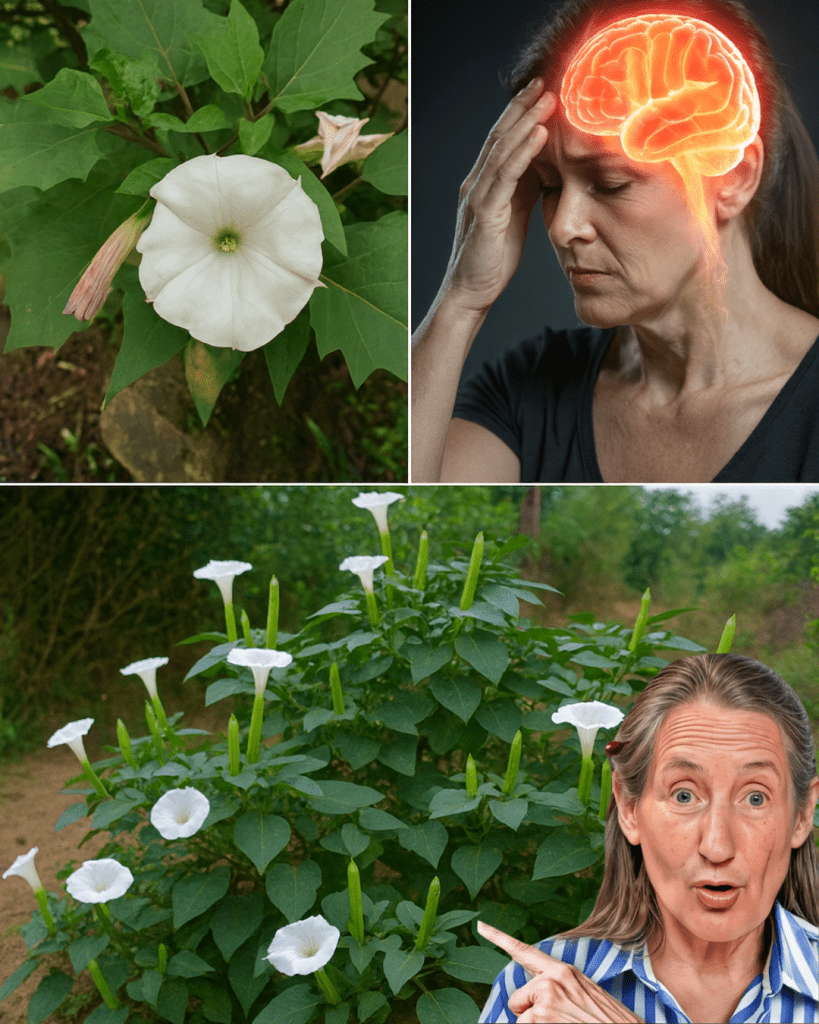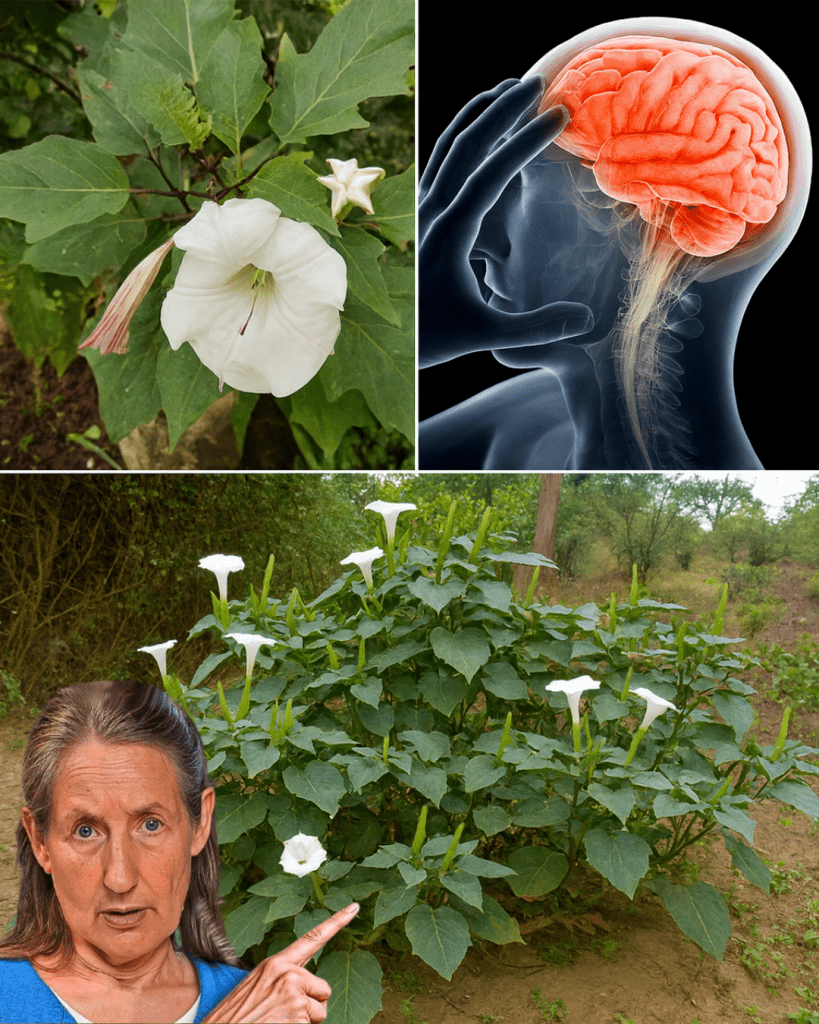Imagine stumbling upon a plant so breathtakingly beautiful that it seems to belong in a fairy tale—large, trumpet-shaped flowers glowing in shades of white, purple, or yellow, releasing a sweet fragrance under the moonlight. This is the Datura genus, often called Devil’s Trumpet or Thorn Apple, a plant as mesmerizing as it is menacing. Beneath its enchanting exterior lies a toxic nightmare capable of causing severe illness or even death. From its spiky seed pods to its potent alkaloids, Datura is a plant you must avoid at all costs. Ready to uncover the hidden dangers of this deceptive beauty and learn how to protect yourself and your loved ones? Let’s dive into the world of Datura and why it’s a risk you can’t ignore

🌿 What Is the Datura Genus?
Datura belongs to the Solanaceae (nightshade) family, a group notorious for its toxic members, including deadly nightshade and belladonna. Native to the Americas but now found worldwide, Datura thrives in disturbed soils, along roadsides, and even in gardens where it’s sometimes mistaken for an ornamental gem. Its striking features include:
- Flowers: Large, trumpet-shaped blooms in white, purple, or yellow, often blooming at night with a haunting fragrance.
- Seed Pods: Spiky, round capsules packed with toxic seeds.
- Growth: Hardy, fast-growing shrubs that adapt to various environments.
Every part of the Datura plant—leaves, stems, flowers, seeds, and roots—is highly poisonous, making it one of nature’s most dangerous creations.
🌟 Common Datura Species You Might Encounter
The Datura genus includes several species, each as toxic as the next. Here are the most common culprits to watch out for:
🥀 Datura stramonium (Jimsonweed or Thorn Apple)
Known for its white or purple trumpet-shaped flowers and spiky seed pods, this species is infamous for its hallucinogenic properties. Even small amounts can cause severe poisoning, making it a frequent cause of accidental harm.
🌼 Datura metel (Horn of Plenty)
With large, showy flowers in white, yellow, or purple, this species is often cultivated for its beauty. Historically used in Ayurvedic medicine, its misuse can lead to life-threatening consequences due to its high toxicity.
🌙 Datura inoxia (Moonflower)
Featuring fragrant, white, night-blooming flowers, this species is often confused with harmless moonflower vines, leading to accidental poisonings. Its seeds and flowers are particularly rich in toxic alkaloids.
⚠️ Datura ferox (Long-spined Thorn Apple)
Identified by its extra-large, spiny seed pods, this species is among the most toxic due to its high alkaloid concentration, posing an extreme risk to anyone who encounters it.
🧪 The Toxic Powerhouse: Datura’s Dangerous Alkaloids
The danger of Datura lies in its tropane alkaloids—atropine, scopolamine, and hyoscyamine—which disrupt the central nervous system. These compounds interfere with acetylcholine signaling, a critical neurotransmitter, leading to devastating effects on the body and mind. Even minimal exposure through ingestion, inhalation, or skin contact can trigger severe symptoms, and the unpredictable alkaloid concentration makes every encounter a gamble.
🚨 Symptoms of Datura Poisoning
Datura poisoning is a medical emergency, with symptoms appearing within 30-60 minutes and potentially lasting 24-48 hours or longer. Exposure can occur through ingestion, inhalation, or skin contact, and the effects are both terrifying and life-threatening. Key symptoms include:
- Hallucinations and Delirium: Vivid, often frightening hallucinations that can lead to disorientation and dangerous behavior.
- Dilated Pupils and Blurred Vision: Sensitivity to light and impaired focus, making navigation difficult.
- Dry Mouth and Difficulty Swallowing: Classic signs of atropine poisoning, leaving victims parched and uncomfortable.
- Rapid Heart Rate and High Blood Pressure: Cardiovascular strain that can escalate to serious complications.
- Seizures, Coma, or Death: In severe cases, respiratory failure or cardiac arrest can occur, making immediate medical attention critical.
⚡ Why Datura Is a Risk You Can’t Ignore
Datura’s beauty is a trap, and its dangers are profound. Here’s why you should steer clear:
💀 Lethal in Small Doses
Even a few seeds or a small piece of the plant can trigger severe poisoning, making accidental ingestion a significant risk, especially for curious children or pets drawn to its vibrant flowers and spiky pods.
🎲 Unpredictable Effects
The concentration of toxic alkaloids varies widely between plants and even within the same plant, making it impossible to predict the severity of exposure. What seems like a minor encounter could turn deadly.
🐶 Toxic to Pets and Livestock
Datura is equally dangerous to animals, including dogs, cats, and livestock. Ingestion can lead to rapid illness or death, so vigilance is essential in areas where Datura grows.
🧒 High Risk for Children
The plant’s colorful flowers and curious seed pods are dangerously attractive to children, increasing the likelihood of accidental poisoning.
🛡️ Safety Tips to Protect Yourself and Others
To stay safe from Datura’s deadly allure, follow these essential precautions:
- Avoid Contact: Never touch Datura plants, as toxic compounds can be absorbed through the skin. If handling is unavoidable, wear gloves and protective clothing.
- Keep Away from Kids and Pets: Ensure Datura is out of reach, especially in gardens or areas where children and animals play.
- Remove Safely: If Datura is in your garden, uproot it carefully and dispose of it in sealed bags—never compost it.
- Educate Others: Share knowledge about Datura’s dangers to prevent accidental exposure in your community.
- Choose Safer Alternatives: Opt for non-toxic plants like hibiscus or Brugmansia (Angel’s Trumpet, less toxic with proper care) for similar beauty without the risk.

🩺 What to Do in Case of Poisoning
If you suspect Datura poisoning, act immediately:
- Seek Emergency Medical Help: Call emergency services or rush to a hospital. Time is critical.
- Do Not Induce Vomiting: Unless directed by a medical professional, avoid giving milk or alcohol, as these can worsen symptoms.
- Provide Plant Samples: If possible, bring a sample of the plant to help doctors identify the toxin and administer targeted treatment, such as activated charcoal or antidotes for anticholinergic effects.
🌱 Why Awareness Matters
Datura’s haunting beauty is a stark reminder that nature’s most alluring creations can hide deadly secrets. While its trumpet-shaped flowers and spiky pods may tempt you to take a closer look, the risks of poisoning, unpredictable effects, and harm to pets and children make it a plant to avoid at all costs. By understanding its dangers and spreading awareness, you can protect yourself, your loved ones, and your community from this toxic threat.
🚀 Take Action to Stay Safe
Don’t let Datura’s beauty fool you—its toxicity is a serious threat. Inspect your garden, educate your family, and choose safer plants to keep your space vibrant and safe. If you encounter Datura in the wild or your backyard, leave it untouched and warn others of its dangers. Share this knowledge to prevent accidental poisonings and embrace the power of informed gardening. Your safety starts with awareness—act now to keep Datura’s deadly allure at bay!
Disclaimer: This article is for informational purposes only and does not replace professional medical advice. If you suspect Datura poisoning, seek emergency medical help immediately.









